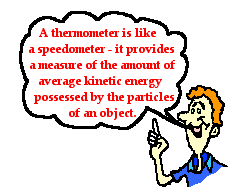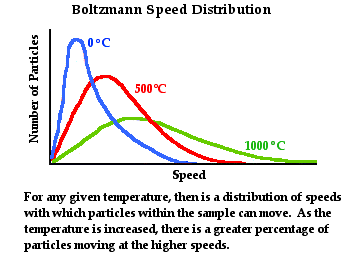Hold down the T key for 3 seconds to activate the audio accessibility mode, at which point you can click the K key to pause and resume audio. Useful for the Check Your Understanding and See Answers.
On the previous page of this lesson, temperature was defined as the reading on a thermometer. The process of calibrating a thermometer was explained and the variety of commonly used temperature scales were described. Finally, the concept of an absolute lowest temperature was discussed. But in the end, the fundamental definition of temperature was not given. Temperature was only defined in practical terms - the reading on a thermometer. Now we have to answer the more fundamental question: what is the reading on a thermometer the reflection of? What is temperature a measure of?
 Temperature as a Measure of Kinetic Energy
Temperature as a Measure of Kinetic Energy
It is at this point that we can use a more sophisticated definition of temperature. Temperature is a measure of the average kinetic energy of the particles within a sample of matter. In a previous unit of The Physics Classroom Tutorial, kinetic energy was defined as the energy of motion. An object ... or a particle ... that is moving has kinetic energy. There are three common forms of kinetic energy - vibrational kinetic energy, rotational kinetic energy and translational kinetic energy. Up to this point of the Tutorial, we have associated kinetic energy with the movement of an object (or particle) from one location to another. This is referred to as translational kinetic energy. A ball moving through space has translational kinetic energy. But an object can also have vibrational kinetic energy; this is the energy of motion possessed by an object that is oscillating or vibrating about a fixed position. And a mass attached to a spring has vibrational kinetic energy. Such a mass is not permanently displaced from its position like a ball moving through space. Finally an object can have rotational kinetic energy; this is the energy associated with an object that is rotating about an imaginary axis of rotation. A spinning top isn't moving through space and isn't vibrating about a fixed position, but there is still kinetic energy associated with its motion about an axis of rotation. This form of kinetic energy is called rotational kinetic energy.
A sample of matter consists of particles that can be vibrating, rotating and moving through the space of its container. So at the particle level, a sample of matter possesses kinetic energy. A warm cup of water on a countertop may appear to be as still as can be; yet the particles that are contained within it have kinetic energy. At the particle level, there are atoms and molecules that are vibrating, rotating and moving through the space of its container. Stick a thermometer in the cup of water and you will see the evidence that the water possesses kinetic energy. The water's temperature, as reflected by the thermometer's reading, is a measure of the average amount of kinetic energy possessed by the water molecules.
 When the temperature of an object increases, the particles that compose the object begin to move faster. They either vibrate more rapidly, rotate with greater frequency or move through space with a greater speed. Increasing the temperature causes an increase in the particle speed. So as a sample of water in a pot is heated, its molecules begin to move with greater speed and this greater speed is reflected by a higher thermometer reading. Similarly, if a sample of water is placed in the freezer, its molecules begin to move slower (with a lower speed) and this is reflected by a lower thermometer reading. It is in this sense that a thermometer can be thought of as a speedometer.
When the temperature of an object increases, the particles that compose the object begin to move faster. They either vibrate more rapidly, rotate with greater frequency or move through space with a greater speed. Increasing the temperature causes an increase in the particle speed. So as a sample of water in a pot is heated, its molecules begin to move with greater speed and this greater speed is reflected by a higher thermometer reading. Similarly, if a sample of water is placed in the freezer, its molecules begin to move slower (with a lower speed) and this is reflected by a lower thermometer reading. It is in this sense that a thermometer can be thought of as a speedometer.
Boltzmann Speed Distribution and Average Kinetic Energy
At the onset of this page, temperature was defined as a measure of the average amount of kinetic energy possessed by an object. But what exactly is meant by average kinetic energy? In any sample of matter, particles are moving. Consider the sample of helium gas inside of a helium-filled balloon. The predominant motion of the helium atoms is translational motion. The helium atoms move through the space of the balloon from one location to another. As they do, they encounter collisions with one another and with the balloon walls. These collisions result in changes in speed and direction. As a result, there is not a single speed at which the helium atoms move, but a range of speeds. Being that there is a range of speeds with which the helium atoms move, there is a range of kinetic energies possessed by these particles. This is often referred to as a Boltzmann speed distribution and is represented graphically by the diagram below. We will return to discuss this topic in the next chapter of The Physics Classroom Tutorial.

If you've been following through this lesson from the beginning, then you understanding of temperature is becoming increasingly sophisticated. You now know that the temperature is more than what the thermometer reads; it is a reflection of the average kinetic energy with which the particles move. The macroscopic description of matter - a thermometer reading - is tied to a particulate description of matter - the speed with which particles move. Now we have to probe the question: what is the relationship between temperature and heat? What is heat? Is temperature the same thing as heat? Is temperature in any way related to heat? What is the cause of heat? These are the questions that we will ponder in the next section of Lesson 1.
Check Your Understanding
1. Consider two samples of different gases. One sample consists of helium atoms and the other sample consists of diatomic oxygen molecules. If the samples are at the same temperature, will the particles within the sample have the same average speed?
2. The particles in a sample of table salt (sodium chloride) are not free to move about. They are locked in place in a structure known as a crystal lattice. Can the particles of sodium chloride possess kinetic energy?